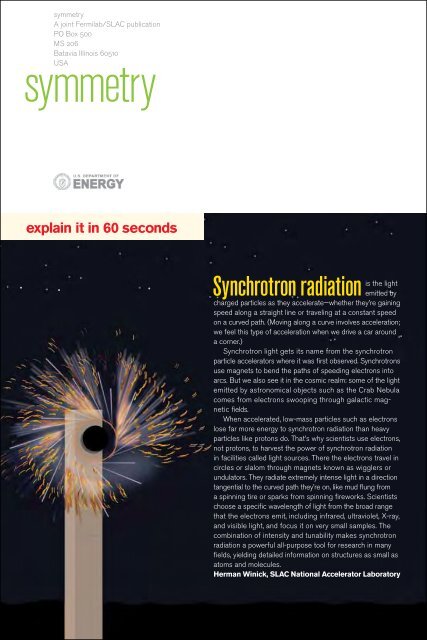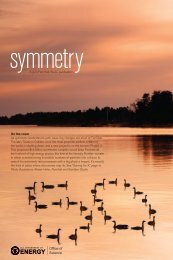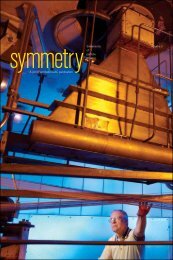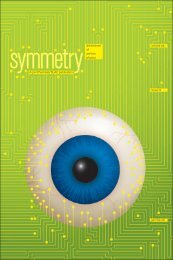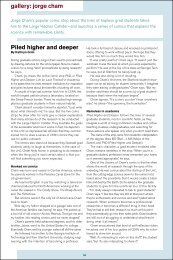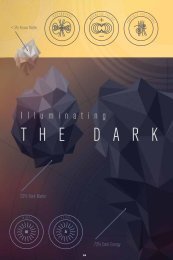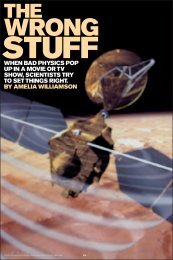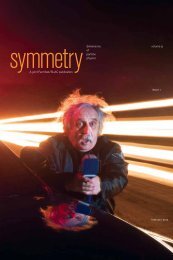pdf of the issue - Symmetry Magazine
pdf of the issue - Symmetry Magazine
pdf of the issue - Symmetry Magazine
You also want an ePaper? Increase the reach of your titles
YUMPU automatically turns print PDFs into web optimized ePapers that Google loves.
symmetry<br />
A joint Fermilab/SLAC publication<br />
PO Box 500<br />
MS 206<br />
Batavia Illinois 60510<br />
USA<br />
symmetry<br />
explain it in 60 seconds<br />
Synchrotron radiation<br />
is <strong>the</strong> light<br />
emitted by<br />
charged particles as <strong>the</strong>y accelerate—whe<strong>the</strong>r <strong>the</strong>y’re gaining<br />
speed along a straight line or traveling at a constant speed<br />
on a curved path. (Moving along a curve involves acceleration;<br />
we feel this type <strong>of</strong> acceleration when we drive a car around<br />
a corner.)<br />
Synchrotron light gets its name from <strong>the</strong> synchrotron<br />
particle accelerators where it was first observed. Synchrotrons<br />
use magnets to bend <strong>the</strong> paths <strong>of</strong> speeding electrons into<br />
arcs. But we also see it in <strong>the</strong> cosmic realm: some <strong>of</strong> <strong>the</strong> light<br />
emitted by astronomical objects such as <strong>the</strong> Crab Nebula<br />
comes from electrons swooping through galactic magnetic<br />
fields.<br />
When accelerated, low-mass particles such as electrons<br />
lose far more energy to synchrotron radiation than heavy<br />
particles like protons do. That’s why scientists use electrons,<br />
not protons, to harvest <strong>the</strong> power <strong>of</strong> synchrotron radiation<br />
in facilities called light sources. There <strong>the</strong> electrons travel in<br />
circles or slalom through magnets known as wigglers or<br />
undulators. They radiate extremely intense light in a direction<br />
tangential to <strong>the</strong> curved path <strong>the</strong>y’re on, like mud flung from<br />
a spinning tire or sparks from spinning fireworks. Scientists<br />
choose a specific wavelength <strong>of</strong> light from <strong>the</strong> broad range<br />
that <strong>the</strong> electrons emit, including infrared, ultraviolet, X-ray,<br />
and visible light, and focus it on very small samples. The<br />
combination <strong>of</strong> intensity and tunability makes synchrotron<br />
radiation a powerful all-purpose tool for research in many<br />
fields, yielding detailed information on structures as small as<br />
atoms and molecules.<br />
Herman Winick, SLAC National Accelerator Laboratory


